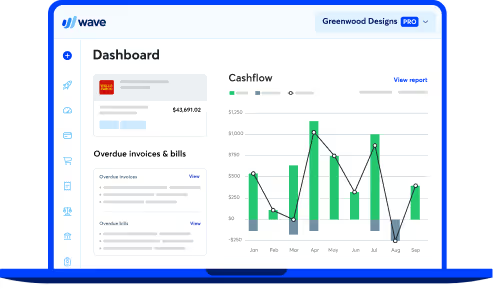
4 small business tax mistakes (and how to solve them)
With 2018’s tax season in the rearview mirror, and 2019’s tax season just around the corner, we’re revisiting the mistakes our new tax customers encountered and how we helped them get back on track. Here are the four most common problems we saw.
1. Surprise tax bill
Ever open a credit card bill and get shocked over the amount owed? We saw many tax customers in that situation except it wasn’t a bill but a large sum due with their tax returns.
In 2019, the highest federal tax rate for individuals is 35%. State income taxes can vary from 0% to as high as 13.3%. Self-employed business owners are also subject to self-employment taxes on their business profits, which can add an additional 15.3% of tax (before self-employment tax deduction).
Tax debt can really add up quickly, sometimes as much as tens of thousands of dollars.
Solution: Set aside money and make quarterly estimates
It’s quite easy to avoid this pitfall if you implement a sustainable bookkeeping routine.. An amazing colleague of mine wrote this article to assist small business owners with their cash flow including setting up an account for taxes. For those who aren’t behind on their taxes, setting aside funds for your taxes as soon as you are profitable means you’ve covered your tracks when tax season comes around, and can focus on managing your business instead.
For most self-employed individuals, taxes must be paid quarterly: by April 15, June 15, September 15 of the current tax year, and January 15 of the following year.
If you have fallen behind and do not have the funds to pay your taxes when your returns are due, speak to your tax advisor about setting up a payment plan with the IRS. If you do not have a tax advisor or can’t afford one, you can contact the IRS online for payment options. Tax deadlines are serious, but the government does support small businesses with flexible plans.
2. Accidental payroll
Most small business owners are considered to be self-employed by the IRS. This means unless the business is incorporated, you can’t be both owner and an employee of your business.
Sole proprietors, general partners in a partnership, and member-managers (any member involved in the management) of an LLC are all considered to be self-employed by the IRS. If you fall into one of these categories, you do not need to be on the business’s payroll. The only exception is if your business is considered a corporation for tax purposes, such as a C-Corporation or an S-Corporation.
We see too many business owners pay themselves as employees, even though their tax structure prohibits it. The IRS states that paying yourself as an employee when you are self-employed is prohibited, so following the rules can be very useful in saving time and headaches.
Solution: Stop payroll and amend payroll returns, pay quarterly estimates instead
If your business is not a corporation and you have paid yourself as an employee through payroll, and have remitted payroll withholdings, you should stop immediately! Contact your tax advisor as soon as possible to see how this can be remedied. You may be able to amend the payroll returns and get a refund for the withholding submitted. Instead, you would submit taxes through quarterly estimated tax payments as we discussed above.
3. Reasonable compensation
If your business is a C-Corporation or an S-Corporation, and you provide services to your incorporated business, the IRS considers you to be an employee and you must be compensated through payroll for those services.
The IRS states that you must pay yourself reasonable compensation for your services. Generally speaking, reasonable compensation is what you would pay someone else to do the same job you are doing in the open market.
Reasonable compensation is mandatory. We see too many corporations not paying any salary, while others paying too much or too little. All of these are problems.
Solution: Research for support or pay back amounts drawn
The IRS uses professional valuators, databases, surveys and salary studies to determine reasonable compensation for any service provided. That being said, you don’t necessarily have to pay for a salary report from a valuator, and can use other resources to support a reasonable salary. If the IRS challenges the compensation you’ve paid yourself, you can present your research and findings to validate the amount you pay yourself is reasonable and industry-standard.
You can use job posting salaries for employment in your area that are similar to the service you’re offering. If you were previously employed at a different company, and then started a business on your own in a similar role, the salary you were paid from your previous employment could be support for the amount you pay yourself now.
Figuring out reasonable compensation can be difficult, so we always recommend you speak with your tax advisor as a starting point.
4. Paying for personal items with your business account
The line between business and personal can get blurry, but the IRS requires clear records when it comes to your tax filings. Personal expenses should be kept separate from any business costs. If you are putting personal expenses through the business, you very likely owe additional taxes: you might owe income and payroll tax liabilities on top of those unaccounted expenses.
In a corporation’s case, these expenses can be deemed as salary. This could mean that you owe additional amounts for income and payroll taxes.
Here’s an example: Let’s say you used your business to pay for $1,000 of personal expenses instead of paying yourself a wage through your corporation. If you did not pay yourself reasonable compensation, the IRS may treat this as if you issued yourself a paycheck of $1,000 of net pay after tax and payroll withholding. In this example, you would have needed to pay yourself gross wages of $1,500 to get a net paycheck of $1,000. On paper, you’ve created a $500 income and payroll tax liability by using your business to pay for personal expenses. In short, you owe the IRS $500.
Not remitting or paying an employee’s share of payroll taxes can land business owners in serious trouble with the IRS. The penalty can be 100% of the tax due for all directors and owners of the corporation, and even possible jail time as it is considered a criminal offence!
Solution: Shareholder loans with interest, or set up payroll to cover tax remittances
If you take out money on behalf of your business and plan to put it back shortly afterwards, the amount used to pay for personal expenses could be documented as a shareholder loan. A shareholder loan must be documented properly: the IRS usually wants to see a note payable, or shareholder’s loan agreement, with interest being charged by the corporation and regular payments being made by the shareholder. Failure to do so could result in the IRS deeming the amount as taxable income to the shareholder, which means additional income taxes and costs to your business.
You can alternatively run catch-up payroll and remit payroll taxes as soon as possible (if this is a payroll-related expense). Setting up payroll in Wave is easy, and our customer experience team can help you along the way
Still confused? That’s okay, Wave Advisors is here to help. Our year-round tax service can help you in calculating your quarterly estimates. If you are behind with your books and need to get caught up, our Wave Advisors team also provides monthly accounting and bookkeeping services that get you organized and back on track. Learn more about our Wave Advisors services.
(and create unique links with checkouts)
*While subscribed to Wave’s Pro Plan, get 2.9% + $0 (Visa, Mastercard, Discover) and 3.4% + $0 (Amex) per transaction for the first 10 transactions of each month of your subscription, then 2.9% + $0.60 (Visa, Mastercard, Discover) and 3.4% + $0.60 (Amex) per transaction. Discover processing is only available to US customers. See full terms and conditions for the US and Canada. See Wave’s Terms of Service for more information.
The information and tips shared on this blog are meant to be used as learning and personal development tools as you launch, run and grow your business. While a good place to start, these articles should not take the place of personalized advice from professionals. As our lawyers would say: “All content on Wave’s blog is intended for informational purposes only. It should not be considered legal or financial advice.” Additionally, Wave is the legal copyright holder of all materials on the blog, and others cannot re-use or publish it without our written consent.


























